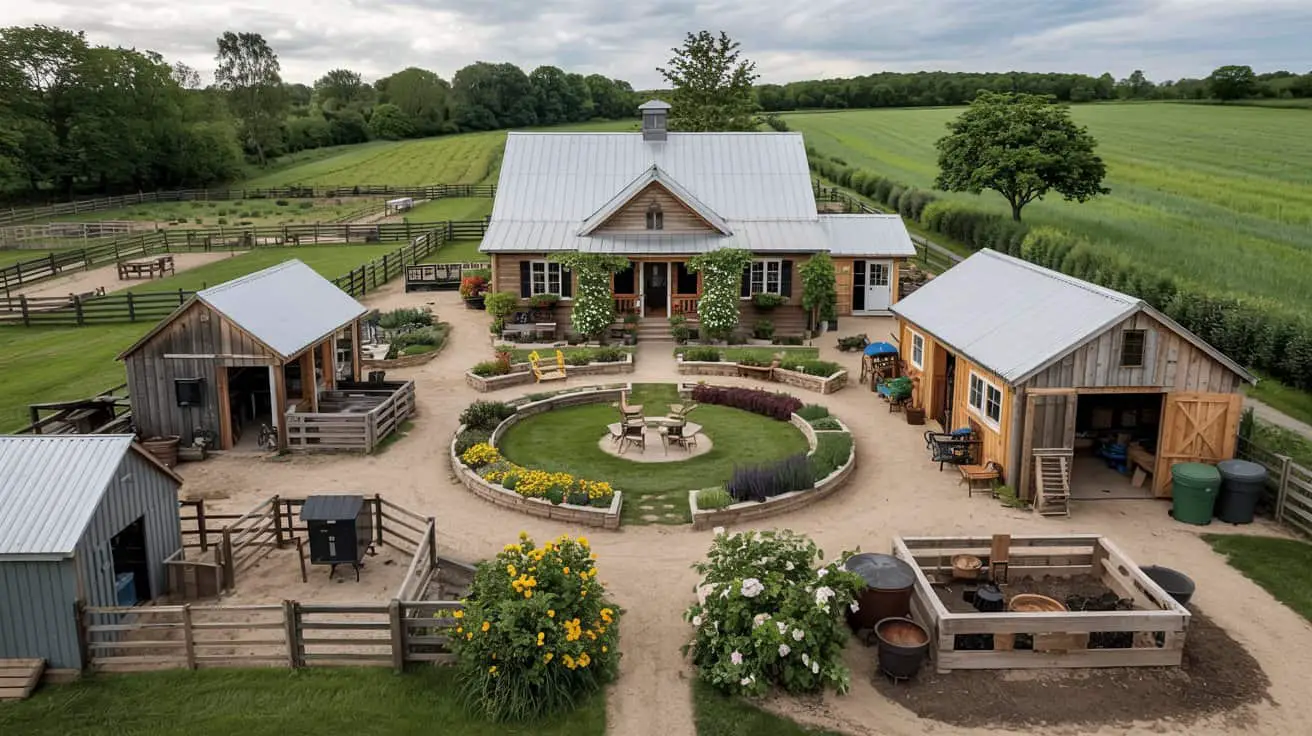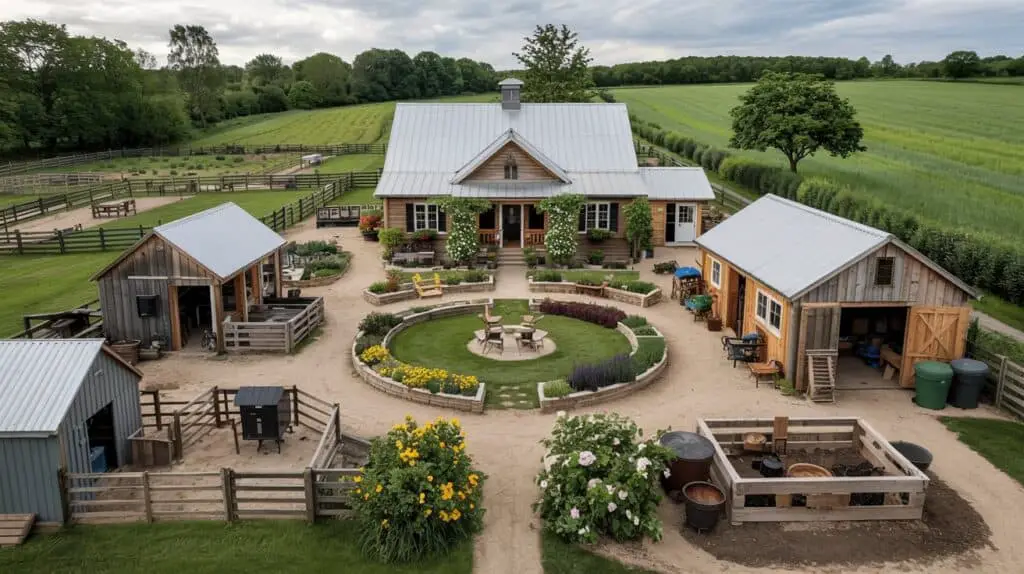
There’s something deeply grounding about the idea of a hobby farm. Maybe it’s the smell of soil after rain, or that feeling when you collect your first basket of homegrown vegetables and think, okay, maybe I could do this full-time someday. For many of us, a hobby farm isn’t just about crops or animals — it’s about freedom, space, and living life on our own rhythm.
The funny thing is, even small farms need big planning. Whether you’ve got a spare acre behind the house or a few open fields, it all comes down to layout. Where do you put the chicken coop? How do you keep your herb garden within easy reach of the kitchen? And what about that dream greenhouse that’s been sitting on your Pinterest board for years?
Designing a hobby farm is like crafting a lifestyle blueprint — one that’s functional, beautiful, and a little bit personal. The goal isn’t perfection; it’s finding what works for you. So, here are nine inspiring hobby farm layout ideas that balance purpose and personality — spaces that feel alive, practical, and full of the quiet charm that makes farm life so addictive.
1. The 1-Acre Mini Farm Layout
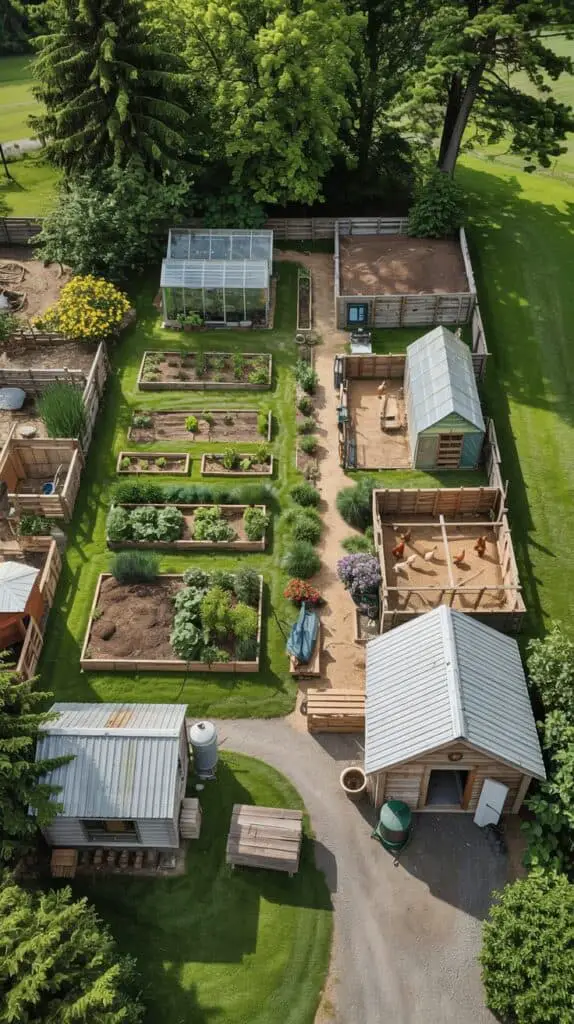
This design proves that size doesn’t define success. On just one acre, you can grow vegetables, raise a few chickens, and still have room for a cozy farmhouse garden. The key is zoning — separating your space into functional areas that complement each other.
Picture this: the house sits near the front of the property with a gravel driveway and small tool shed beside it. Behind, rows of raised vegetable beds lead to a compact greenhouse and compost corner. A fenced chicken run occupies the far corner, shaded by trees, while a small herb and flower garden lines the pathway back to the house.
From above, it’s neat but not rigid — every section flows naturally. Add a small rainwater tank near the greenhouse and solar panels on the roof, and you’ve got a self-sustaining, low-maintenance setup. It’s proof that with the right design, one acre can feel like an entire countryside.
2. The 2-Acre Family Homestead
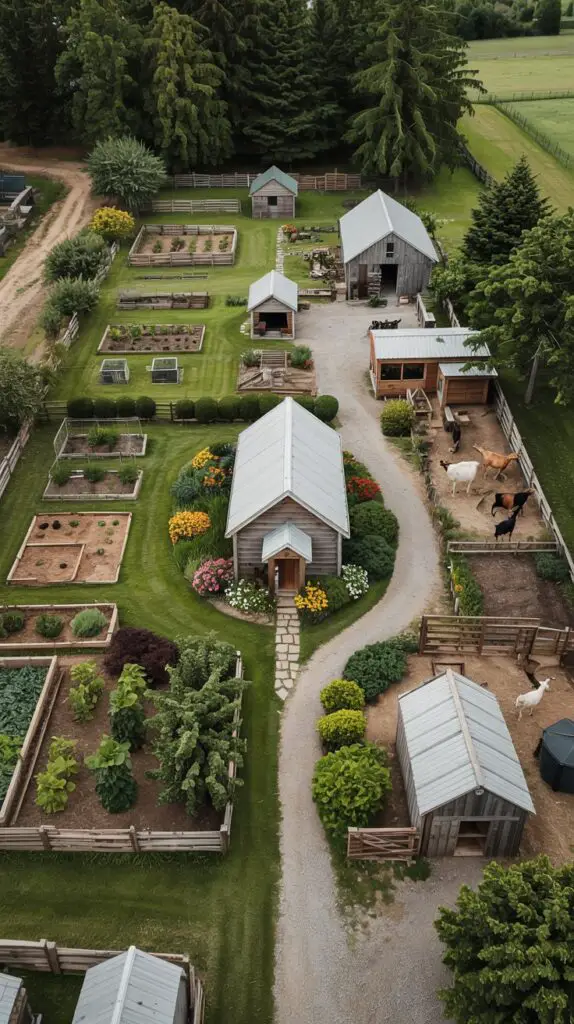
If the 1-acre layout is cozy, the 2-acre version is its slightly more ambitious sibling. With double the space, you can think bigger — maybe a goat pen, orchard, or small pond.
The farmhouse sits near the center, framed by gravel driveways and garden paths. To the west: fruit trees and berry bushes arranged in neat rows. To the east: vegetable beds and a small greenhouse. The back section holds a barn, chicken coop, and a fenced grazing area for goats or sheep.
This layout suits families who want to live sustainably while keeping things manageable. From an aerial view, it’s balanced — home in the middle, life surrounding it. The front yard remains inviting with flowers and a seating area, while the back focuses on function. It’s homesteading with a touch of order, built around comfort and care.
3. The 5-Acre Dream Farm
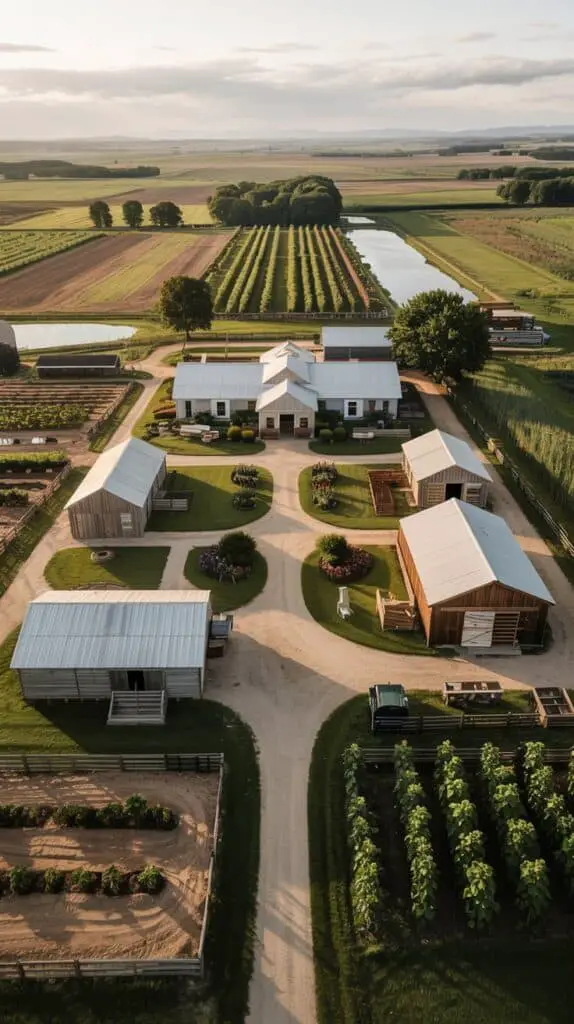
Five acres opens up endless possibilities — space for livestock, a farm shop, and even a family compound layout. The design starts with a wide driveway leading to a central courtyard surrounded by multiple buildings: farmhouse, barn, workshop, and guest cabin.
Crops and orchards take up one side of the property, while a pond and grazing fields fill the other. A long gravel lane connects everything, making it easy to move between areas by tractor or bike.
From the air, the 5-acre layout looks like a patchwork of purpose — every section serving a clear role. Yet it still feels personal: maybe a row of sunflowers along the fence, a shaded bench by the pond, or a children’s play garden near the orchard.
It’s the ideal size for families transitioning from hobby farming to a small-scale commercial setup — plenty of room to grow but still close enough to feel like home.
4. The Modern Homesteading Aesthetic
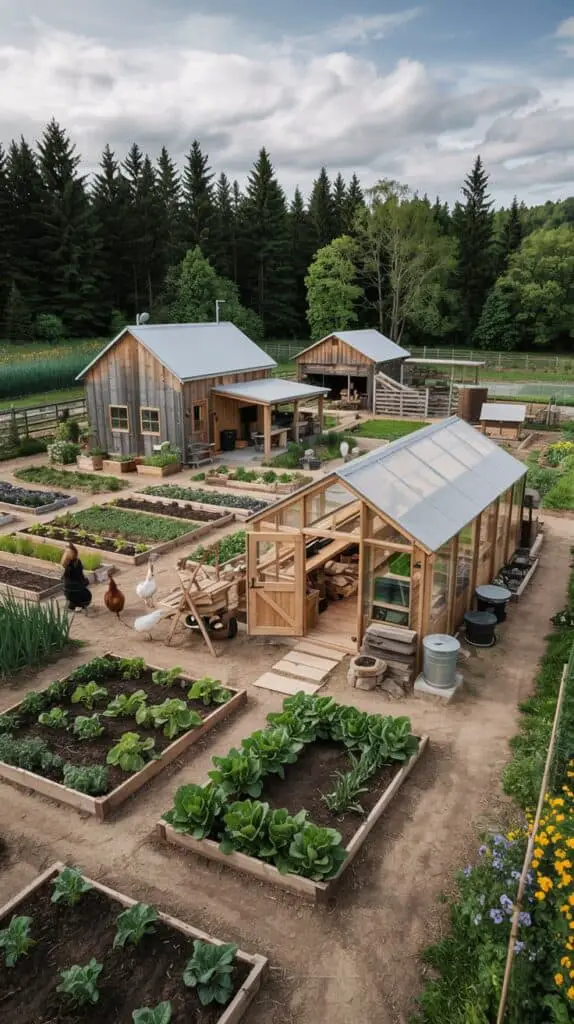
This layout is for those who want the farm life and the aesthetic — think rustic wood mixed with minimalist design. The goal is a clean, functional setup that still looks good on camera (because let’s be honest, part of the fun is showing it off a little).
The house and greenhouse sit side by side, both simple and sleek — white-painted walls, dark roofs, and wide doors opening to the garden. Pathways connect to vegetable plots arranged in symmetrical grids, each bordered by wildflowers for pollinators. A small barn or workshop sits behind the house, with chickens roaming a fenced section nearby.
A rainwater collection tank, compost station, and neatly stacked firewood pile make it both eco-friendly and photogenic. It’s sustainable living, styled. Perfect for small farm vloggers or anyone who loves a bit of organization with their mud.
5. The Mini Farm and Market Stand Combo
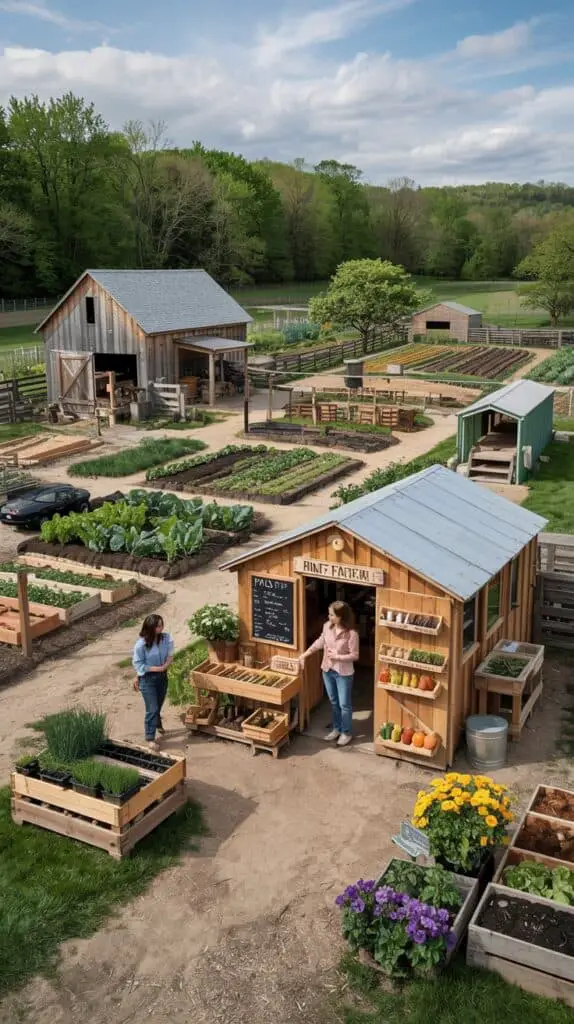
For hobby farmers who love to share what they grow, this layout blends production with community. The front portion of the property becomes a welcoming farm stand or roadside stall, while the back remains your personal farm haven.
Picture a small wooden stand near the entrance, shaded by an overhang, where you sell vegetables, honey, and flowers. Behind it, neat garden rows stretch toward a modest barn and a few animal pens. A gravel lane connects the front and back, keeping the flow natural for both visitors and daily chores.
The layout is compact but full of charm — perfect for families wanting to dip into the local market scene. Add a few picnic tables or a herb garden display near the stand, and suddenly your mini farm isn’t just functional; it’s a destination.
6. The Hobby Farm With a Central Courtyard
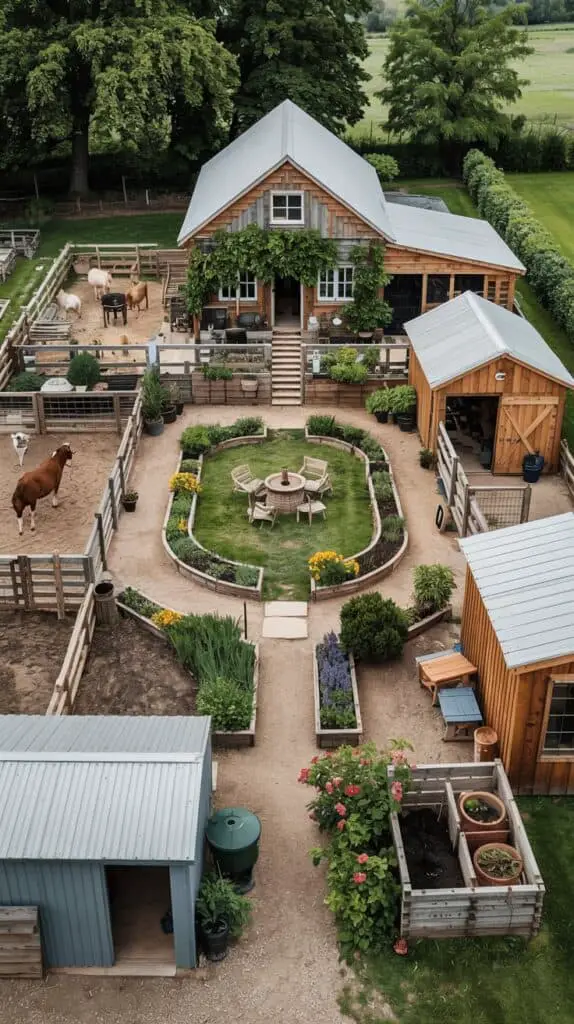
Some of the most beautiful hobby farms are designed around a courtyard — a functional and social heart that ties everything together. From above, this type of layout looks symmetrical and organized, with the home, barn, workshop, and gardens all surrounding a shared open space.
The main farmhouse faces the courtyard directly, maybe with a wide porch or pergola covered in climbing plants. To one side, there’s a small animal barn and fenced paddock; to the other, a shed or workshop. The far side might hold raised vegetable beds, fruit trees, and a compost area.
The central space itself can be gravel or grass, with outdoor seating or even a small firepit for cool evenings. What makes this layout so livable is its practicality — every part of the farm stays connected without feeling cramped. It’s ideal for families who enjoy hosting friends or just like having an open, communal feel in their everyday farm life.
It’s a design that makes daily chores feel less like tasks and more like part of a simple, fulfilling rhythm — everything within sight, everything with purpose.
7. The Garden-Focused Hobby Farm
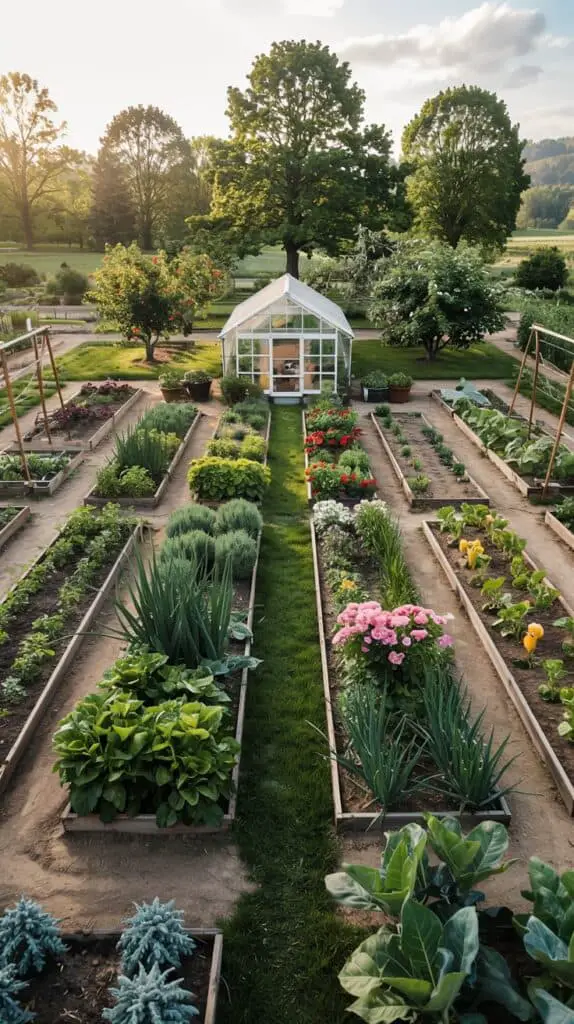
Not every hobby farmer wants animals or acres of crops — some just want to live surrounded by gardens. This layout focuses on ornamental and edible plant design, creating a lush, colorful environment that doubles as a productive space.
The farmhouse sits at one edge of the land, looking out over a series of structured gardens: herb spirals, raised vegetable plots, and pathways framed by lavender and rosemary. A greenhouse sits near the back, with a shaded area for seed trays and potting benches. Along the sides, fruit trees and climbing vines create a sense of enclosure.
A small pond or water feature adds life — frogs, dragonflies, and birds make the space feel alive. It’s a layout that feels calm and restorative, perfect for those who see farming as therapy as much as livelihood.
From an aerial perspective, it’s a patchwork of green and texture — organized but full of personality. It’s the kind of place where every path invites you to stop and smell something growing.
8. The Shared Family Compound Layout
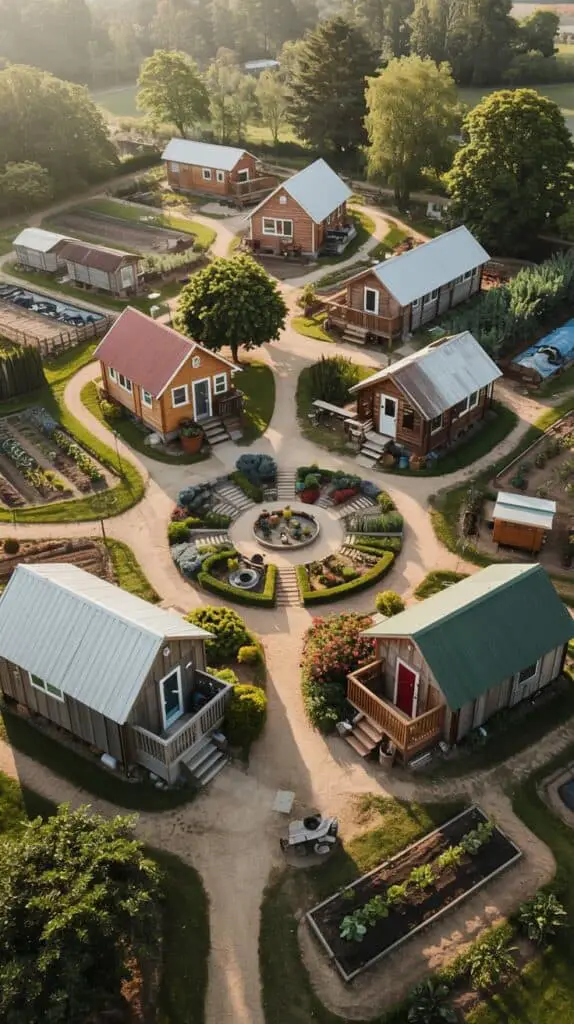
This design is built for families who dream of building a generational home — multiple small houses or cabins sharing one piece of land, connected by gardens, paths, and shared farm facilities.
At the center, there’s a large communal garden or green space where everyone can gather — think picnic tables, outdoor kitchen, maybe even a shared barn. Around it, each small home or cabin sits privately among trees or flower beds.
To one side, a collective orchard and vegetable garden supply food for everyone, while a few animal pens sit beyond for chickens, goats, or rabbits. The design balances privacy and community beautifully — everyone has their own corner, but daily life naturally flows together.
From above, it looks like a small village: warm, connected, and designed for shared living. It’s ideal for families, close friends, or even community-based homesteaders who believe life (and chores) are better done together.
Final Thoughts
Every hobby farm tells a story — of curiosity, creativity, and the search for something slower and more meaningful. The beauty of designing one is that there’s no single “right” layout. What matters is how the land feels when you walk through it — the mix of open fields, tidy gardens, and the quiet rhythm of life taking shape.
Some layouts are neat and structured, others more wild and free. But all share the same heart: a desire to live closer to nature and make everyday life just a little more intentional. Whether it’s one acre or five, your hobby farm doesn’t need to be perfect — it just needs to feel like you.
Because at the end of the day, a hobby farm isn’t just about growing plants or raising animals — it’s about designing a life that grows alongside you.

